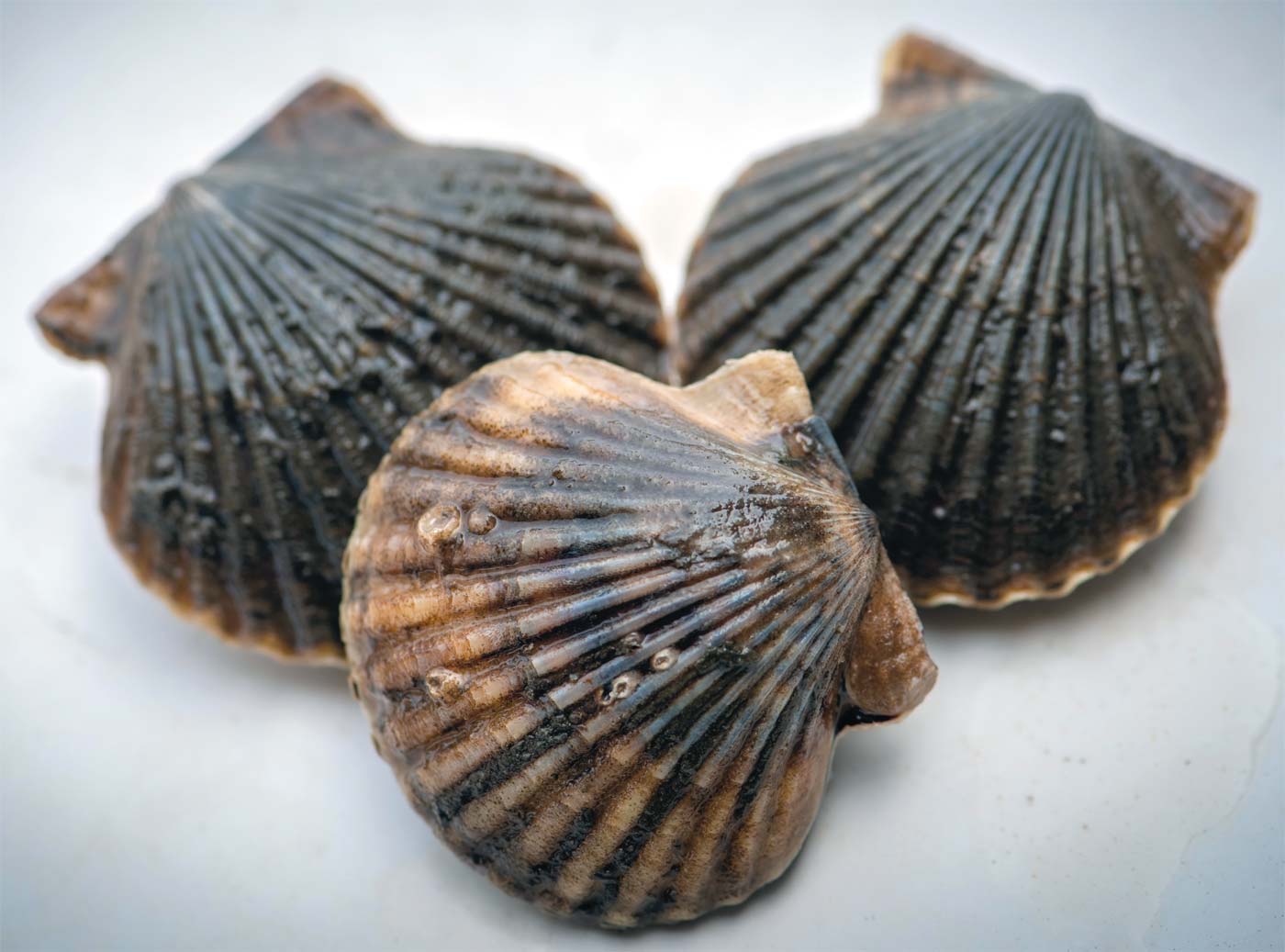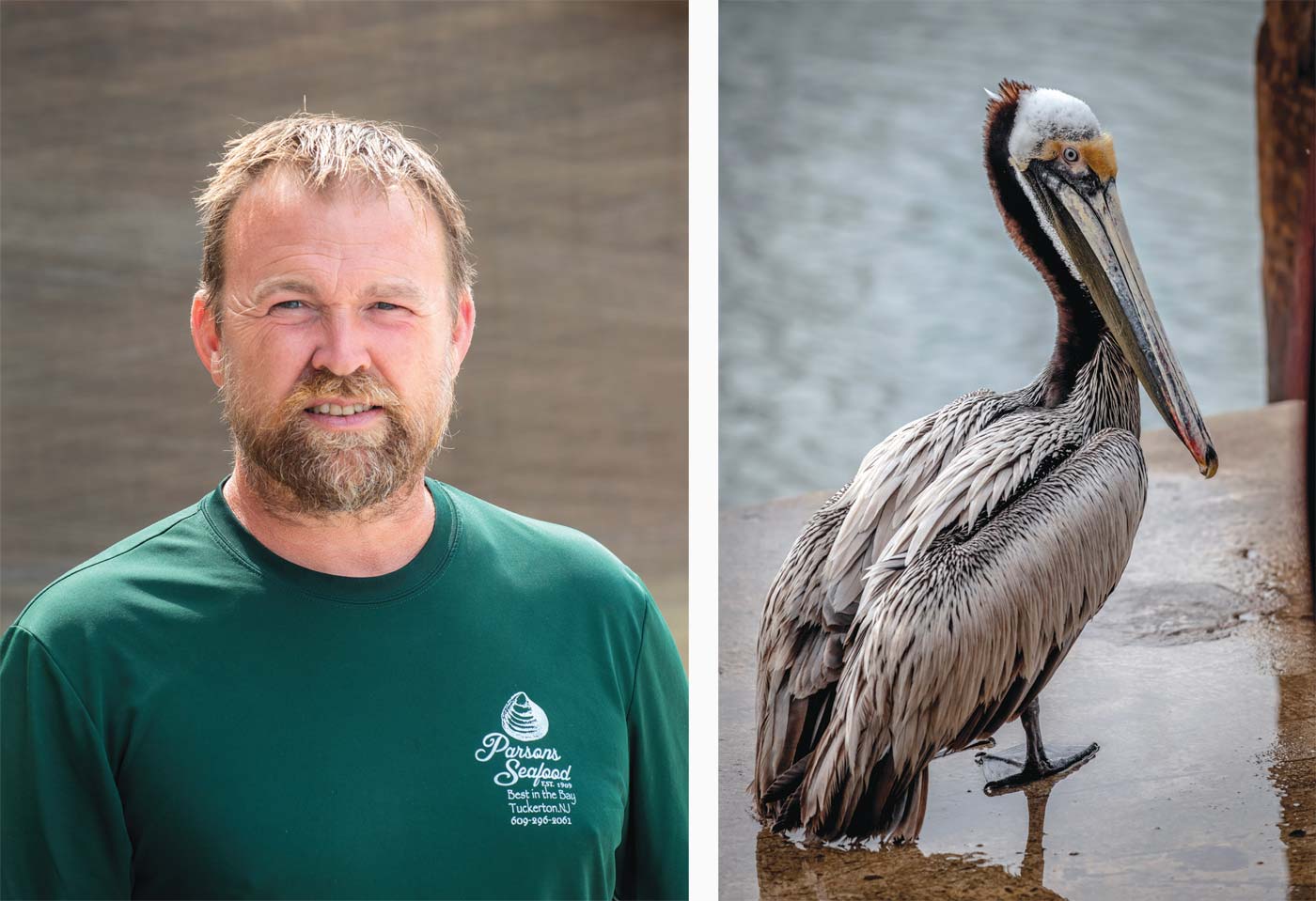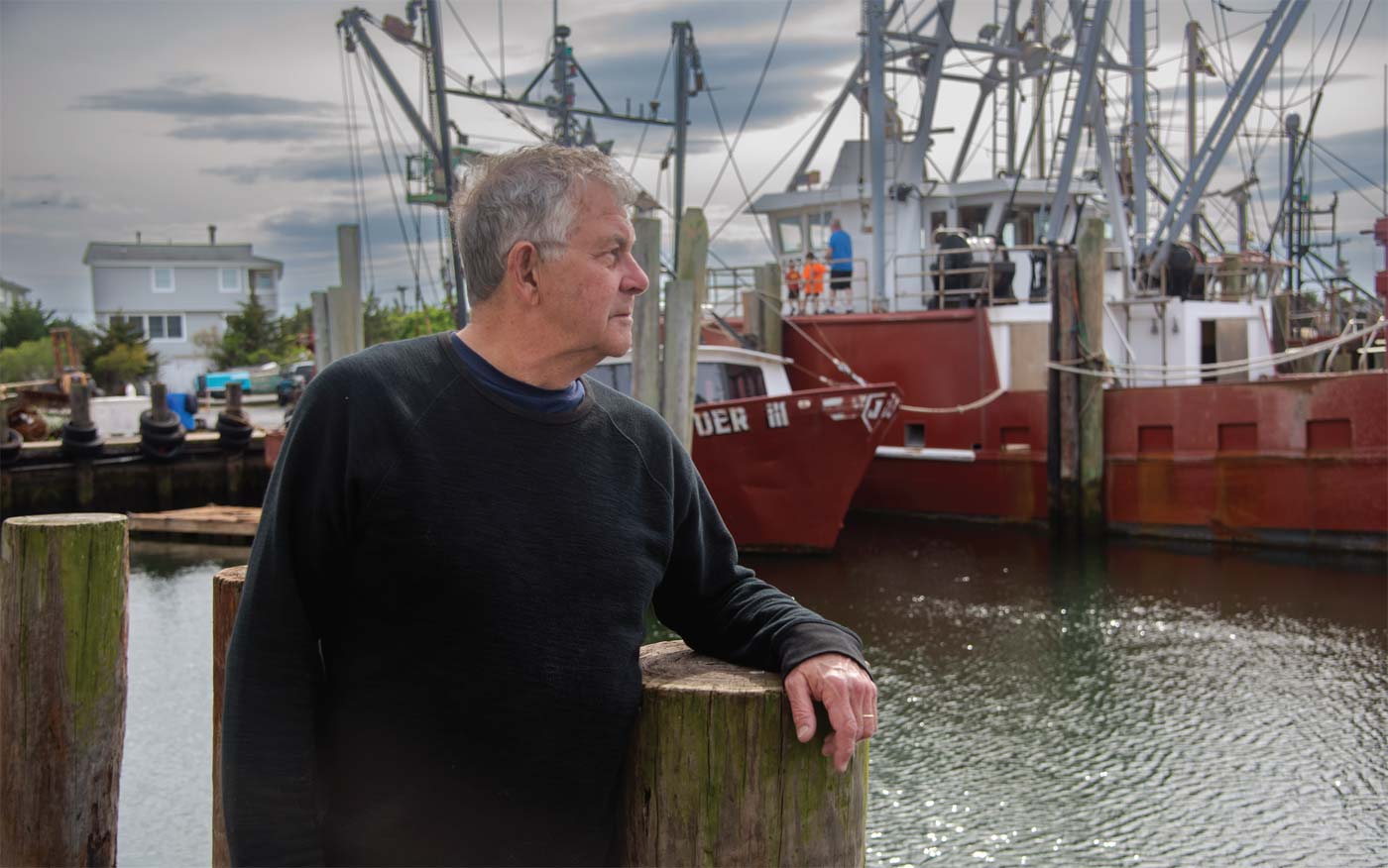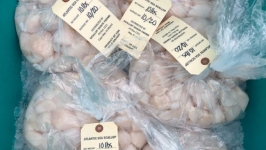A New Season for Jersey Scallops

Ernie Panacek, longtime general manager of Viking Village Seafood in Barnegat Light, remembers a time 50 years ago when bay scallops were harvested in abundance at the southern Jersey Shore. Things have changed with Barnegat Bay since then.
To thrive and grow, bay scallops rely on free-flowing bay currents and nutrients carried by the water. That access has been diminished over the past few decades by overdevelopment near the coastline and by beach replenishment projects. But in recent years, Rutgers researchers and oyster farmers have been working to rebuild New Jersey’s bay scallop industry and efforts are also underway to harvest more Atlantic Ocean sea scallops.
A Trenton native with a degree in accounting from Marquette University, Panacek “grew up under a truck,” learning truck mechanics at his father’s business in Trenton. His passion for seafood, background in accounting, and experience with engine repair made Panacek well-suited for the GM post at Viking Village, the busy commercial fishing dock located at the northern tip of Long Beach Island. It’s a position he’s held since 1989.
The Viking Village fleet consists of 20 scallop boats, and in 2019 they landed and shipped in excess of 2 million pounds of scallops. Scallop boats also go fishing out of cooperatives in Belford, Point Pleasant, and Cape May.
When asked about the sharp rise in price of fresh and frozen Atlantic ocean scallops in recent years—with frozen scallops selling for as much as $40 a pound in the supermarket—Panacek, himself a former scallop fisherman, has a pragmatist’s long-term view.
“Prices have gone up for a lot of reasons,” he says. “Inflation, customer demand, the freight to move them, fuel costs for the boats…. We’ll have bonanza harvests again, but last year, this year, and probably next year, production isn’t going to be all that great.”
He predicts a renaissance for ocean scallops in three to four years as prices dip, as he knows of large juvenile populations of ocean scallops 25 to 40 miles offshore that will be ready to meet the demand.
BAY VS. OCEAN
New Jersey waters are home to both bay and ocean scallops, and many people don’t know there are differences between the two.
Bay scallops are smaller while Atlantic scallops from colder ocean waters as far as 25 miles offshore can grow to slightly larger than a golf ball. Bay scallops can reach harvestable size within a year while Atlantic scallops usually take three to four years to achieve a harvest-friendly size.
Smaller bay scallops also have the potential to become a booming industry in New Jersey as they can be carefully looked after and grown in cages, or “farmed,” like oysters. Ocean scallops are tightly regulated and have to be harvested from existing supplies.
The Atlantic Ocean scallop season is year-round. Boat captains have maximum catch quota allocations and an annual limit of 24 days at sea regulations they must abide by, set down by the National Marine Fisheries Service. For obvious reasons, harvesting of Atlantic scallops is slower in winter months.
“With ocean scallops we’re on a cycle,” Panacek explains, noting that late fall and winter are, traditionally, the down cycle. “In April and May, [the scallops] start to improve and begin to grow up,” he adds. May through August is usually the best time to get bigger catches of ocean scallops.
“There’s really no correlation between bay scallops and sea scallops,” says Panacek. “They are two independent stocks and the one doesn’t have anything to do with the other, but to me, the [Atlantic] sea scallop industry looks very promising”.
“Bay scallops don’t go into the ocean and ocean scallops stay offshore,” he says, adding, “from what I understand there is little farming of bay scallops in Barnegat Bay or in Great Bay.”
SUPPORT FOR AN INDUSTRY
All that could change in a matter of years as Rutgers researchers have just wrapped up a four-year study raising bay scallops in parts of Barnegat Bay, working with oyster farmers already there.
The study, made possible by a grant from the Sea Grant Consortium/U.S. Department of Commerce, was led by Ximing Guo of Rutgers’ Haskin Shellfish Research Lab in Port Norris, who served as principal investigator.
“For years, Barnegat Bay had a good population of bay scallops,” Guo says. “Now, we are trying to see if we can get aquaculture going again. Maybe our testing efforts will also help repopulate the bay. The [bay scallops] have potential to naturally repopulate the bay, so that is cause for hope based on our experiments with farming them.”
Working with veteran oyster farmers Matt Gregg of Forty North Oyster Farms in Brick, Dale Parsons of Parsons Mariculture in Tuckerton, and Marc Zitter of Northern Cape Sea Farms in Cape May, Guo’s team is a well-rounded mix of experts, including Lisa Calvo, Daphne Munroe, and David Bushek from Rutgers, Peter Rowe of the NJ Sea Grant Consortium, and Mike DeLuca of the New Jersey Aquaculture Innovation Center. They’ve discovered that bay scallops hatched in March and deployed in cages into the bay in early July can be harvested in December with low mortality rates.
Bay scallops were started at the shellfish hatchery at Rutgers Aquaculture Innovation Center in Cape May, and researchers sought to breed more disease-resistant scallops each year for three consecutive years
“We would take the top 20 percent to select the next generation and the plan was to harvest them within the year, so we did that for three generations,” Guo explains, noting that bay scallops naturally die off before their second summer. The shell of a bay scallop is 2½ to 3 inches long.
Not unlike the recently retired Lisa Calvo, who spent years working with oysters at Haskin Shellfish Lab in Port Norris, Guo’s passion for bay scallops is infectious.
“They are so tasty. Bay scallops are much tastier than ocean scallops, in my opinion,” Guo enthuses.
Guo, who left his native China 40 years ago, notes East Coast bay scallops from the U.S. were introduced to China 30 years ago.
“It’s a huge industry there now. They raise over 1.5 million pounds of bay scallops every year, so we import some bay scallops from China, but we can do it ourselves here, and do it better,” he argues.

Dale Parsons of Parsons Seafood in Tuckerton
BAY SCALLOPS HAVE THE POTENTIAL TO BECOME A BOOMING INDUSTRY IN NEW JERSEY AS THEY CAN BE GROWN IN CAGES, OR “FARMED,” LIKE OYSTERS.
Reminded of the current political and trade situation with China, Guo adds: “Politics is one thing, but when you import scallops that are frozen and processed, you have no control over quality. If you have a local product that is shipped to restaurants right away, you have a premium product.”
Seeds, which can be developed in a hatchery or collected as extremely miniature scallops from native waters, are key to farming initiatives. Once the seeds of juvenile bay scallops grow to about ½ inch, they can be placed into cages and moved about easily in the bay to continue growing into adulthood, thus the partnership with area oyster farmers. Oysters, surf clams, and bay scallops were the three species of shellfish studied for the Sea Grant Consortium study, which began in 2018 and concluded in the summer of 2022. Put into cages and placed in bay waters, bay scallops can be harvested within five months, much faster than oysters and surf clams, which may take as much as 18 to 20 months until harvest.
A NEW STAR FOR NJ AQUACULTURE?
Daphne Munroe, an expert on surf clams and ocean scallops, sees great opportunity for a bay scallop farming industry in Barnegat and Great Bay in coming years.
“I think there’s great potential for this species. It hasn’t been a traditional farm species, so bay scallops are a new candidate for aquaculture,” Munroe says.
“Atlantic sea scallops are a major fishery [industry] here in New Jersey and, of course, an important product,” she notes, before adding that, unlike bay scallops, she does not consider sea scallops a strong candidate for farming in New Jersey. Although actively farmed in the colder waters of the Gulf of Maine, Atlantic sea scallops don’t do well in the warm waters off the Jersey coast.
Dale Parsons of Parsons Seafood in Tuckerton agrees with Munroe’s outlook regarding bay scallops, and adds that bay scallops are like any other species: “If the seeds are available, farmers will utilize them.” What’s needed, he says, is a commercial seed producer.

Ernie Panacek of Viking Village
“PRICES HAVE GONE UP FOR A LOT OF REASONS,” PANACEK SAYS. “INFLATION, CUSTOMER DEMAND, THE FREIGHT TO MOVE [THE SCALLOPS], FUEL COSTS FOR THE BOATS.”
“We’re not really doing bay scallops on any kind of commercially sustainable scale yet.”
“Rutgers will do the genetic work to produce the line of seeds, but for them to produce the number of seeds that would be required for bay scallop farming on a large scale is a whole different game.”
In other words, Rutgers is, in effect, the engineer designing the car, but then an assembly line of manufacturers is needed to put cars together for the public.
“This is normally something developed by industry, not by academia,” says Parsons. “We need a private hatchery to adopt bay scallop culture along with hard clams and oysters.”
Parsons knows of two New England–based hatcheries for bay scallops, hard clams, and oysters.
“The problem we have with bay scallops is an increase in a new type of predation that’s feeding on most of the scallops that we see in the bay every summer,” Parsons says. The cow nose sting ray is ravaging baby and juvenile populations of Barnegat Bay scallops every year. He cites the lack of tidal flow, except for the bay’s eastern end closest to the ocean, as another issue.
“Tidal flow has been greatly diminished due to all the beach replenishment programs. From Barnegat Inlet to Little Egg Harbor Inlet, there has been a constant flow of beach replenishment. That beach replenishment sand will wash away in one single storm and end up in the inlets,” says Parsons.
“Now there is an island outside of Little Egg Harbor Inlet that is the result of an overbuilt beach replenishment program. It’s a massive island that is a half a mile in diameter, all due to beach replenishment.”
Despite the problems with the flow of water in Barnegat and Great Bay that scallops, surf clams, and oysters—all filter feeders—depend on for their nutrients, Parsons is optimistic about the future of bay scallop farming in the Garden State.
“The opportunity is there, but the industry needs a consistent supply of seed,” he reiterates, adding “it’s important to know where these seeds were developed and how they were developed before the industry uses it as a farm product. That’s where it all starts: with the geneticists and with the seed guy who designs the animal we put in the bay.”
Panacek is hopeful that bay scallops can come back in great numbers soon, “because they used to catch a lot of them 60, 70, and 80 years ago.” For now, he looks at the positive side.
“Sea scallops are still a big industry on the East Coast off the Atlantic here.”

FARMERS OF THE OCEAN
A husband-and-wife team in North Cape May considers themselves farmers of the ocean.
Brady Lybarger and Amanda Axelsson launched Scallop Shack Farms in Cape May at the height of the pandemic in 2020, making good use of Facebook and Instagram to grow their new scallop business. The couple both love sea and bay scallops, but their company focuses primarily on sea scallops for now. When asked about inflated costs for Atlantic scallops in the past 10–12 years, Brady says via email, “I think it’s like anything: The cost of going out to sea to bring in a great product caught up to the demand.”
“The name Scallop Shack Farms is because I always call myself a farmer of the ocean. When the scallop is the right size and ready to harvest, I go do what I do best and bring our customers the freshest scallops they have ever had,” adds Brady, who began scalloping with his family in 1999. Amanda works full-time in wine sales for wholesaler Wilson Daniels while handling the company’s “back-office stuff.”
“I prefer behind the scenes, so all the logistics for the sales, email campaigns, the website, bookkeeping,” she says, are her domain. The company has been selling direct to consumers via social media and a booth at the Margate Farmers’ Market, but is looking to expand. “Our hope is to sell direct to local restaurants in the near future. We recently purchased a hook-and-line commercial fishing vessel named ‘F/V Salted,’ and a few restaurants purchased tuna and other products directly from the boat, including Hooked Up Seafood.”
Asked if interest in scallops has waned or price increases have turned people off, Amanda says Scallop Shack Farms has not noticed any decrease in interest.
“I think most of the public understands the cost and hard work behind scalloping, especially in our town of Cape May. Scallop fisherman have so much support from the local community, with Cape May being the second largest seaport for scallop landings [on the East Coast],” Amanda says.
Brady makes regular trips with his scallop crew, running a couple of boats for a private owner who owns 12 scallop boats based in New Bedford, MA, as well as his own F/V Salted. His trips last anywhere from four days to two weeks. Noting the high expense of boats, equipment, and permits, he says he often fishes up in New Bedford, which leads the U.S. in scallop landings. He avoids trips for most of the winter months, however, when it can be downright dangerous.
Atlantic sea scallops are at their healthiest from April to October because of nutrients in the water. A successful trip to New Bedford normally yields between 10,000 and 40,000 pounds of scallops. For Brady, a typical harvest is usually about 18,000 pounds of scallops and involves a week out at sea.
Asked about the ups and downs of a scalloper’s life, Brady says the hardest part can be missing important events and time away from family and friends, but there’s always the bright side: “I get to wake up every day and see the best sunrise and sunsets you could ever imagine.”
Scallop Shack Farms
www.scallopshackfarms.com
New shop opening summer 2023: 1288 Hornet Rd., Rio Grande (inside Cape May Airport complex)






